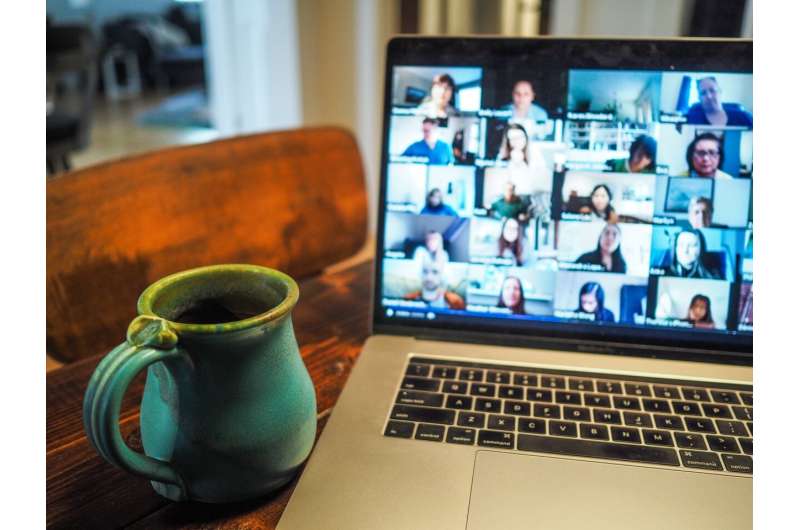Turning video on and seeing others may boost remote class experience

Turning the camera on during a remote class—and seeing more students with their own cameras on—may improve factors critical to a better class experience, according to a team of Penn State researchers.
In two studies on classes using videoconferencing technology, students who turned their cameras on tended to report better engagement, interaction and satisfaction, leading to a better overall class experience. Similarly, when other classmates also used their cameras during class, students tended to experience greater class engagement, interaction and satisfaction, according to the researchers.
Video may help both convey, as well as pick up on, nonverbal cues, said S. Shyam Sundar, James P. Jimirro Professor of Media Effects in the Donald P. Bellisario College of Communications and co-director of the Media Effects Research Laboratory at Penn State. In this respect, remote classes have the potential to be even more engaging than physical classroom experiences, he added.
"From the students' perspective, remote classes can be a very different environment compared to classes that they physically attend," said Sundar, who is also an affiliate of Penn State's Institute for Computational and Data Sciences. "In physical classrooms, the student often only sees classmates peripherally, but on videoconferencing platforms, such as Zoom, they see them front and center on a wall of images of all their classmates, and they can tell who's involved and who's not, who's on video, who has turned on audio and so forth. As a result, the participation of peers becomes very salient."
Yuan Sun, doctoral student in the Donald P. Bellisario College of Communications and co-author of this study, said that students may pick up a range of subtle nonverbal cues when their classmates are also on video.
"You can see your classmates' body language, whether they're smiling, or how they are smiling, so that can actually make people feel more comfortable to turn on their video cameras," said Sun.
Reconsidering anonymity
The findings may make instructors reconsider the importance of student anonymity in these cases, according to Yanting Wu, lead author of the study and a master's student in Penn State's College of Information Sciences and Technology. While instructors may be hesitant to require camera use because it is an intrusion on privacy, the researchers report that lower feelings of anonymity did not detract from the student's engagement or classroom experience.
"One of the big takeaways for us is that, at least in this particular mediated venue, anonymity may not be such a great thing," said Sundar. "We're used to thinking that anonymity fosters free exchanges of ideas while also respecting a student's privacy, but, as it turns out, if you want a good class experience and better engagement, anonymity will not help."
"The use of video, audio and chat functions reduced feelings of anonymity, which in turn was associated with greater class engagement, interaction and satisfaction," said Wu.
The researchers also studied other Zoom features, such as the use of the "raise hand" function. Students who raised their hand felt greater class interaction, according to Wu. They also had higher comfort level, which was associated with better class experience.
While the necessity for video conferencing may be fading as the effects of the pandemic diminishes, remote classes and educational sessions will likely continue. According to the researchers, taking full advantage of video features may be a way to not just make these environments equivalent to in-class meetings, but, in some ways, more engaging.
"There are certain specific things that are possible because of the unique affordances of online video conferencing technologies that are especially relevant and pertinent to synchronous meetings and synchronous classrooms," said Sundar. "Video and audio are critical not simply because they open up a modality to be as rich as possible and as close to face to face as possible, but because they are bringing in the social element, the social presence of you and your peers, which is amplified in a Zoom Room, maybe even more so than in a physical classroom."
The researchers recruited 176 participants for the first study at the beginning of the pandemic to capture students' experience of remote learning. The study asked them to think about their latest remote class experience before filling out a questionnaire. In particular, they were asked about their and their classmates' use of video conferencing features, including video camera usage, audio usage, customization tools and participation tools, such as the "raise hand" feature. In the second study conducted after a year into the pandemic, a total of 256 participants submitted responses about their online video conferencing class experience. The second study examined the same variables as the previous study, but featured refined wording for some of the questions.
The researchers published their work in Proceedings of the ACM on Human-Computer Interaction and presented it at the recent annual conference on Computer-Supported Cooperative Work And Social Computing.
More information: Yanting Wu et al, What Do You Get from Turning on Your Video? Effects of Videoconferencing Affordances on Remote Class Experience During COVID-19, Proceedings of the ACM on Human-Computer Interaction (2022). DOI: 10.1145/3555773
Provided by Pennsylvania State University





















